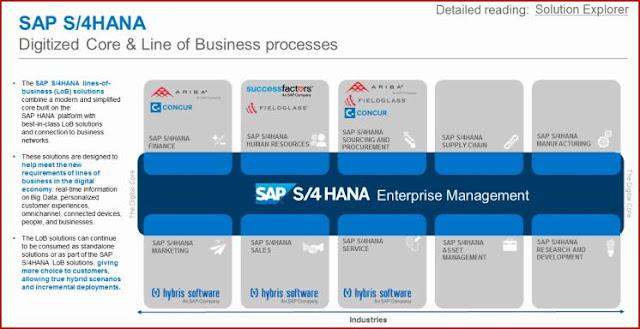Friday, 18 September 2015
SAP Payment Engine
SAP offers the SAP Payment Engine as
a payments solution. The SAP Payment Engine is an advanced solution designed to
help you significantly improve the process for inter-bank and customer-to-bank
payments. By providing shared-service centers and in-sourcing models, the
end-to-end solution streamlines all payments processes, standardizes
interfaces, removes siloed payment applications, and enables the rapid
development of new products.
It works on the Net weaver platform.
There are two versions: version 7.0 and 8.0
Some features of the solution are:
- One-to-one and one-to-many credit transfers and direct debits
- Same-day or even real-time clearing and settlement
- Single, queued and collective postings of internal and external transactions
- Domestic and international transactions
- Flexible customer correspondence (advices, payment exceptions, and payment recalls)
- Extensive monitoring and status management
- Open, multi-channel integration architecture
- Supports multiple connections with SAP as well as non-SAP applications
- High performance levels with significant scalability
Unlock value with tangible business
benefits
- Reduce costs: IT development and maintenance costs, along with manual efforts, can be reduced due to centralization and consolidation of payment services
- Increase extensibility: Open integration architecture helps integrate with multiple payment channels, both inbound and outbound, and can connect with multiple account management systems
- Manage regulatory compliance: Helps your institution comply with regulatory mandates such as single euro payments area (SEPA)
- Enhance risk and liquidity management: The solution helps you combat fraud and money laundering more effectively by enhancing liquidity management
- Improve customer retention: Advanced payment services add an edge to your service offerings and help significantly improve customer satisfaction, loyalty, and retention."
Company codes are set productive
Company codes are set productive
My Client
is on Live SAP system since 10 years and want to set the company codes
status to productive now, as part of requirement of an external system
which pulls data based on productive company codes.
Currently
the status in PRD system for all company codes is not productive as attached.
IF they are set productive now, what would be the impact on financial
areas (Specially AA) if the company codes are set productive now ?
Solution:
there is no retrospective impact of setting company code to productive
at later stages. It implies that data can't be deleted programs from resetting
data in this
company code from that point(activation) onwards.
SAP Contract Accounts Receivable and Payable
SAP Contract Accounts Receivable and
Payable is a subsidiary ledger that is tailored towards the requirements of
industry sectors with a high volume of business partners and a large number of
documents for processing, such as:
·
Electronic Toll Collection
·
Banking (loans)
·
Leasing
·
Retail (mail order business)
·
Postal Services (large scale)
·
Railways (transportation of goods)
·
Internet content sales (for example, Apple-like businesses)
To meet the demands of high-volume business
industries, the solution provides highly flexible processes to allow for a
maximum of automation as well as mechanisms to guarantee outstanding system
performance and scalability. The large number of postings, for example during
billing, are managed in SAP Contract Accounts Receivable and Payable and
uploaded to the general ledger.
Each individual business transaction, that
is, each posting and each document for a given customer, is stored in order to
guarantee itemized verification. These FI-CA documents are cumulated and
transferred periodically to the general ledger of the Financial Accounting (FI)
component or to a non-SAP system. When an FI-CA document is posted, accounts
are determined automatically for G/L Accounting (FI-GL). All receivables,
payables, revenue and expense accounts are automatically determined based on
account assignment details in the line items.
Key functions of SAP Contract Accounts
Receivable and Payable include the following:
·
Mass data processing
·
Reduction of memory space for storing open and cleared items
·
Performance of data change functions
·
Fast data input
·
Acceleration of all critical activities such as posting,
payments, and returns processing
·
Automation of all transactions as far as possible
·
Flexibility and system openness
·
Flexible input format
·
Business process enhancements and seamless integration of
customer-specific data without modification
·
Separation of user interface, checks, data storage
SAP Contract Accounts Receivable and
Payable is suitable for worldwide implementation. It covers various statutory requirements
(such as those that relate to tax legislation and accounting principles) and
country-specific processes (such as the management of payment transactions).
SAP Contract Accounts Receivable and
Payable is the backbone of the broader end-to-end process Consume to Cash in
High Volume Business, which comprises the following processes:
·
Convergent Charging for online rating and charging
·
Convergent Invoicing for converging different billing streams on
one customer invoice
·
Customer Financials Management
– Contracts
Accounts Receivable and Payable (as described above)
– Credit Risk
and Collections Management
– Financial
Customer Care and Dispute Management
The overall end-to-end process serves the
needs of online rating, charging and billing for any recurring or event-driven
services or orders. In addition, Contract Accounts Receivable and Payable
(FI-CA) facilitates the merge of different billing streams into one customer
invoice. Customer Financials Management (CFM) can handle receivables management
and payments, manage credit risk and collections, offer financial customer care
and dispute management, and use electronic bill presentment and payment. In
addition it brings together customer-facing activities and solid financial
capabilities that ensure you comply with legal requirements. As it is compliant
with statutory requirements on an international scale, its auditability is
guaranteed.
Subscribe to:
Comments (Atom)
